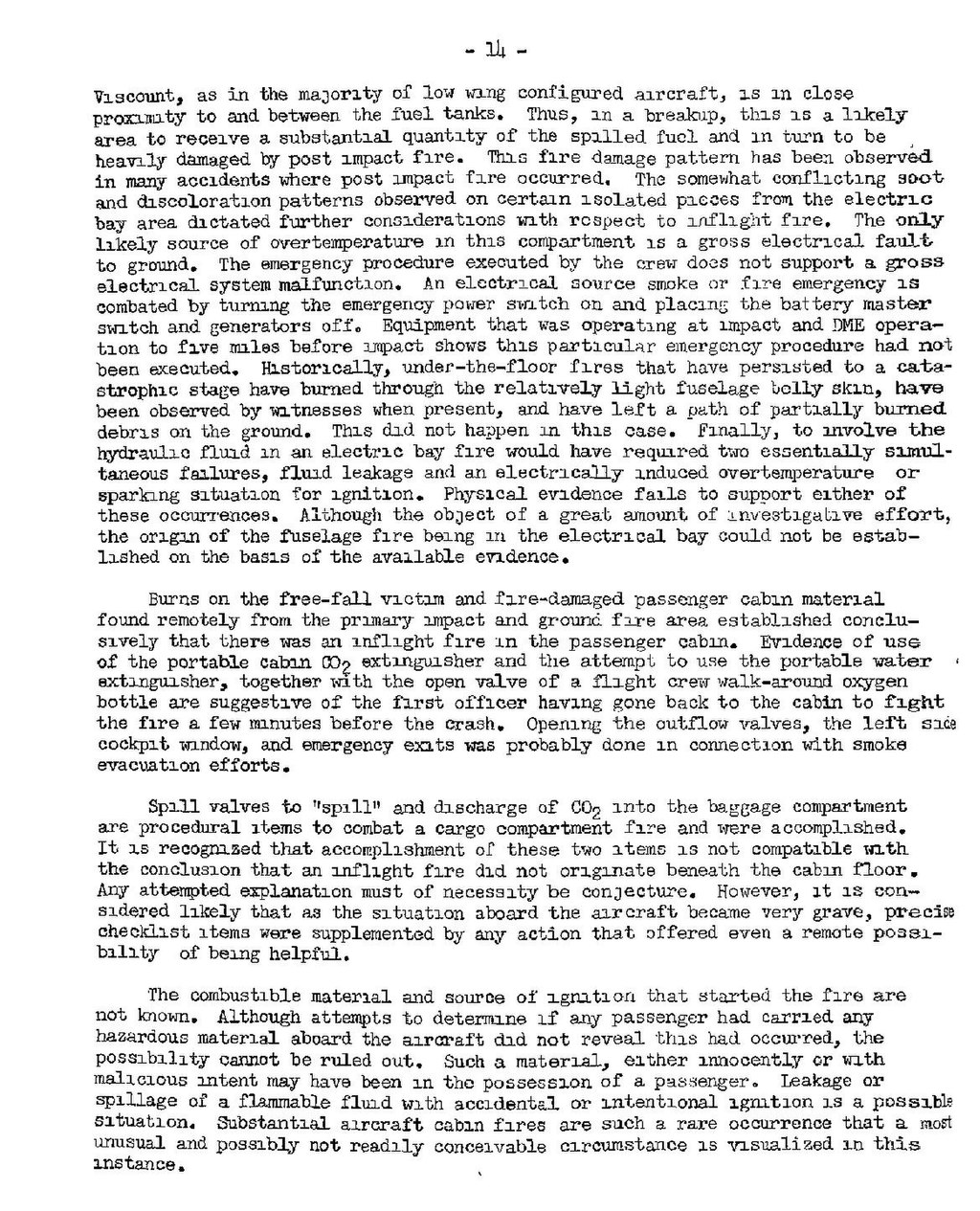- 14 -
Viscount, as in the majority of low wing configured aircraft, is in close proximity to and between the fuel tanks. Thus, in a breakup, this is a likely area to receive a substantial quantity of the spilled fuel and in turn to be heavily damaged by post impact fire. This fire damage pattern has been observed in many accidents where post impact fire occurred. The somewhat conflicting soot and discoloration patterns observed on certain isolated pieces from the electric bay area dictated further considerations with respect to inflight fire. The only likely source of overtemperature in this compartment is a gross electrical fault to ground. The emergency procedure executed by the crew does not support a gross electrical system malfunction. An electrical source smoke or fire emergency is combated by turning the emergency power switch on and placing the battery master switch and generators off. Equipment that was operating at impact and DME operation to five miles before impact shows this particular emergency procedure had not been executed. Historically, under-the-floor fires that have persisted to a catastrophic stage have burned through the relatively light fuselage belly skin, have been observed by witnesses when present, and have left a path of partially burned debris on the ground. This did not happen in this case. Finally, to involve the hydraulic fluid in an electric bay fire would have required two essentially simultaneous failures, fluid leakage and an electrically induced overtemperature or sparking situation for ignition. Physical evidence fails to support either of these occurrences. Although the object of a great amount of investigative effort, the origin of the fuselage fire in the electrical bay could not be established on the basis of the available evidence.
Burns on the free-fall victim and fire-damaged passenger cabin material found remotely from the primary impact and ground fire area established conclusively that there was an inflight fire in the passenger cabin. Evidence of use of the portable cabin CO2 extinguisher and the attempt to use the portable water extinguisher, together with the open valve of a flight crew walk-around oxygen bottle are suggestive of the first officer having gone back to the cabin to fight the fire a few minutes before the crash. Opening the outflow valves, the left side cockpit window, and emergency exits was probably done with smoke evacuation efforts.
Spill valves to "spill" and discharge of CO2 into the baggage compartment are procedural items to combat a cargo compartment fire and were accomplished. It is recognized that accomplishment of these two items is not compatible with the conclusion that an inflight fire did not originate beneath the cabin floor. Any attempted explanation must of necessity be conjecture. However, it is considered likely that as the situation aboard the aircraft became very grave, precise checklist items were supplemented by any action that offered even a remote possibility of being helpful.
The combustible material and source of ignition that started the fire are not known. Although attempts to determine if any passenger had carried any hazardous material aboard the aircraft did not reveal this had occurred, the possibility cannot be ruled out. Such a material, either innocently or with malicious intent may have been in the possession of a passenger. Leakage or spillage of a flammable fluid with accidental or intentional ignition is a possible situation. Substantial aircraft cabin fires are such a rare occurrence that a most unusual and possibly not readily conceivable circumstance is visualized in this instance.
